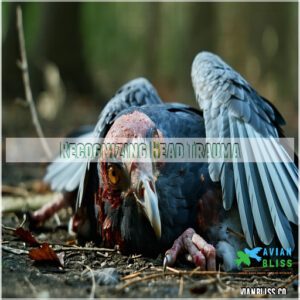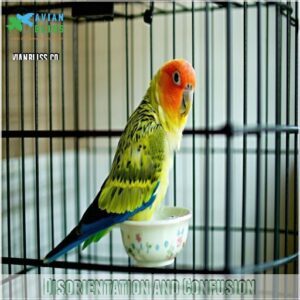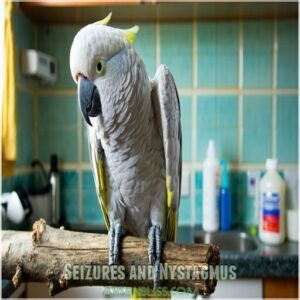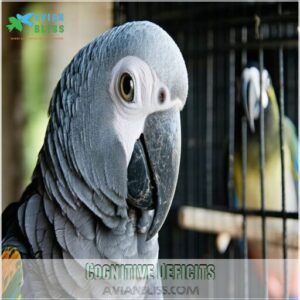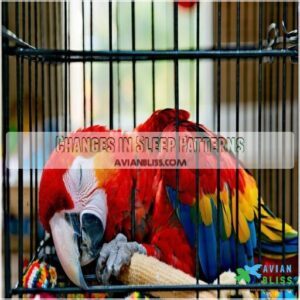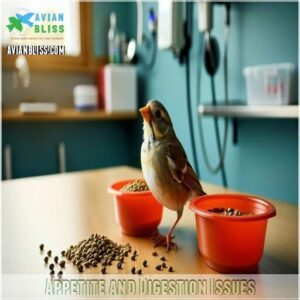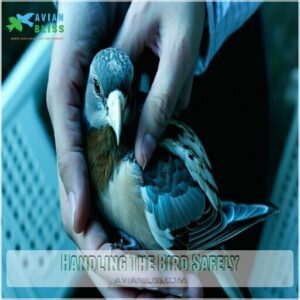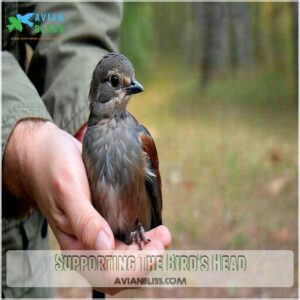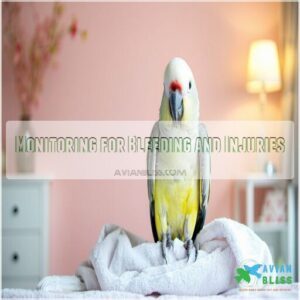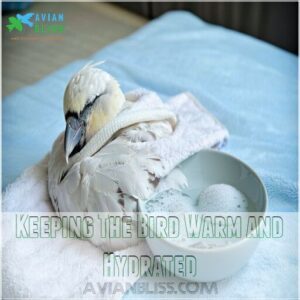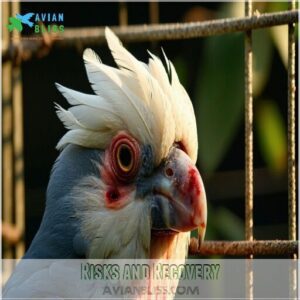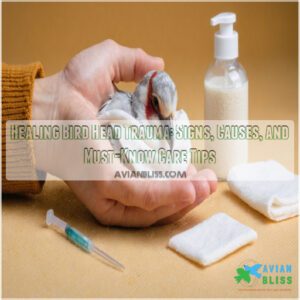This site is supported by our readers. We may earn a commission, at no cost to you, if you purchase through links.
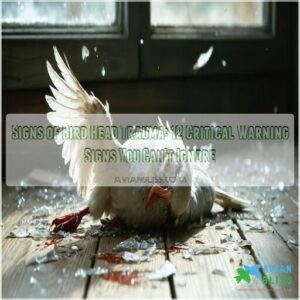
Watch for strange eye movements like nystagmus (uncontrolled flicking), difficulty perching, or a drooping wing.
Disorientation, seizures, or sudden personality changes—like unprovoked aggression—are red flags.
A bird that’s uncoordinated, unconscious, or struggling with appetite or sleep likely has a serious issue.
Common causes include window strikes, predator attacks, or even falls.
If you suspect head trauma, handle the bird gently, keep it warm, and get it to a vet ASAP.
Quick action can mean the difference between recovery and long-term damage.
Prevention tips might surprise you, and understanding the importance of early action can be crucial.
Table Of Contents
- Key Takeaways
- Recognizing Head Trauma
- Common Signs and Symptoms
- Causes of Head Trauma
- Pre-Vet Care and Transportation
- Risks and Recovery
- Frequently Asked Questions (FAQs)
- How do I know if my bird has a head injury?
- What happens if a bird has head trauma?
- Do birds droop after head trauma?
- What happens if a bird twists a head?
- What happens if a bird eats a head injury?
- What causes a bird’s head injury?
- What are the symptoms of head trauma in birds?
- What does a bird with a concussion look like?
- What to do if a bird hits its head?
- Can head trauma affect a birds vocalizations?
- Conclusion
Key Takeaways
- Watch for unusual behaviors like strange eye movements, wing droop, or difficulty perching as early signs of head trauma.
- If your bird shows disorientation, seizures, or sudden personality changes, act fast and get them to a vet immediately.
- Handle injured birds gently, keep them warm, and create a quiet environment to reduce stress before seeking care.
- Prevent head injuries by bird-proofing your home with window decals, covered aviaries, and safe cage placement.
Recognizing Head Trauma
You’ll notice signs of head trauma in your bird through changes in their eyes, posture, and behavior.
These warning signs can help you spot potential injuries early, so you can get your feathered friend the care they need right away.
Strange Eye Movements
One of the most alarming signs of head trauma in birds is unusual eye movement.
You’ll notice your bird’s eyes rolling back or tracking erratically from side to side, a condition called nystagmus.
Watch for sudden pupil changes or uneven dilation between eyes.
Vision loss may occur temporarily or permanently, and these strange eye movements often indicate serious neurological issues that require immediate veterinary attention.
Difficulty Perching
A bird’s graceful perch suddenly becomes a precarious balancing act when head trauma strikes.
If you notice your feathered friend having difficulty perching, stumbling, or falling from their favorite spots, it’s a red flag for potential brain injury.
Balance issues often manifest as perch instability, where they’ll struggle to maintain their grip or use their beak for support.
Watch for repeated falls or reluctance to leave the cage bottom.
Wing Droop
While perching problems often signal trouble, wing droop can be an even more telling sign of bird head trauma.
You’ll notice one or both wings hanging lower than usual, often accompanied by these symptoms:
- Uneven wing positioning that persists for more than a few minutes
- Visible struggle to keep wings tucked against the body
- Failed attempts to adjust wing position when perched
This avian trauma sign needs immediate vet attention, as it often indicates neurological damage affecting wing control.
Loss of Coordination
When your feathered friend loses coordination, it’s a serious sign of bird head trauma.
You’ll notice them stumbling, swaying, or having trouble landing on perches – these balance issues signal potential neurological damage.
Watch for unsteady movements during flight, as coordination loss affects motor skills severely.
If you spot ataxia symptoms like circling or erratic movements, contact an avian vet immediately to address the potential neurological damage.
Unconsciousness
After noticing coordination issues, watch for signs of unconsciousness – the most alarming symptom of bird head trauma.
When your pet loses consciousness, they’ll appear completely unresponsive and limp.
The depth and duration of unconsciousness can indicate the severity of the traumatic brain injury.
Don’t wait to see if they’ll recover naturally – immediate veterinary care is required to prevent permanent damage.
Common Signs and Symptoms
You’ll need to watch for several warning signs that indicate your bird has experienced head trauma, from disorientation and seizures to changes in sleep patterns.
If you notice any unusual behaviors in your feathered friend, particularly changes in alertness or coordination, it’s imperative to seek immediate veterinary care to prevent lasting damage.
Disorientation and Confusion
Now that you can recognize physical signs, watch for disorientation and confusion, classic neurological issues in head-injured birds.
You’ll notice your feathered friend acting like they’ve lost their internal compass.
Here are five tell-tale signs of spatial awareness problems:
- Constant head tilt that doesn’t resolve
- Loss of balance when attempting to perch
- Walking in circles or bumping into cage walls
- Strange eye movements tracking invisible objects
- General confusion about familiar surroundings, acting lost
Bird owners should be aware of head trauma symptoms to provide proper care for their birds experiencing head trauma.
Seizures and Nystagmus
While disorientation might be your first clue, seizures and nystagmus (abnormal eye movements) indicate serious bird head trauma.
You’ll spot seizures as episodes ranging from mild twitching to full-body convulsions.
Nystagmus appears as rapid, uncontrolled eye darting.
| Symptom | Severity | What You’ll See |
|---|---|---|
| Seizures | Critical | Twitching, falling, wing-flapping |
| Nystagmus | Serious | Eyes tracking back-and-forth, rolling |
| Absence seizures | Moderate | Brief "zoning out," stillness |
These neurological responses need immediate vet attention to address the serious condition.
Cognitive Deficits
Cognitive deficits offer significant clues to brain damage in your feathered friend.
You’ll notice memory loss, confusion when approaching familiar toys, or failure to recognize household members.
Learning issues may emerge as they struggle with previously mastered tricks.
Behavioral changes, such as unprovoked aggression or personality shifts, often signal neurological decline.
Bird concussions and traumatic brain injuries commonly manifest through these subtle symptoms before more obvious neurological symptoms appear, indicating a possible neurological decline.
Changes in Sleep Patterns
You’ll spot unusual sleep patterns quickly when your bird experiences head trauma.
Watch for these critical changes:
- Excessive sleepiness during normal active hours
- Sudden nighttime activity when they should be resting
- Falling asleep in odd positions or locations
- Difficulty waking up when stimulated
These sleep disturbances often indicate serious neurological issues, so monitor your bird’s fatigue levels and daytime drowsiness carefully.
Appetite and Digestion Issues
Along with head trauma, you’ll notice significant changes in your bird’s eating habits.
Loss of and digestion problems often signal serious issues that need immediate attention.
Regurgitation, beyond normal crop emptying, can indicate neurological damage.
It’s imperative to recognize these signs to prevent further complications related to common bird diseases.
| Sign | What to Watch For | Action Required |
|---|---|---|
| Food Aversion | Refuses favorite treats | Contact vet immediately |
| Regurgitation | Forceful expulsion | Emergency care needed |
| Eating Difficulties | Dropping food, missing beak aim | Monitor closely |
| Nutrient Deficiency | Weight loss, weakness | Seek avian specialist |
The table outlines specific signs to watch for, including Food Aversion, Regurgitation, Eating Difficulties, and Nutrient Deficiency, each requiring a distinct action to ensure the bird’s health and well-being.
It is crucial to follow these guidelines to provide the best care for your bird, especially in cases of emergency care.
Causes of Head Trauma
You’ll find that birds can suffer head trauma from common hazards like window strikes, fights with other birds, and predator attacks.
Their thin, delicate skulls make them especially vulnerable to injuries from falls and collisions with household items like ceiling fans.
Window Strikes
Window strikes pose a lethal threat to birds, especially during migration seasons.
Your windows’ glass visibility can trick birds into seeing reflections of sky or plants as flight paths, leading to devastating collisions.
These impacts often cause severe bird head trauma, with signs ranging from unconsciousness to coordination loss.
Installing window films or decals effectively prevents night collisions and daytime strikes, protecting our feathered friends from injury.
Understanding bird impact trauma is critical for providing appropriate care and assistance to affected birds, which can help reduce bird impact trauma.
Fights With Other Birds
While birds may seem peaceful, fights between them can turn fierce, leading to serious head trauma.
Birds establish dominance through aggressive encounters that often result in beak injuries and head wounds.
Here’s what typically triggers intraspecies aggression:
- Territory disputes during breeding season
- Competition for food sources and perches
- Dominance battles in mixed-species aviaries
These conflicts can cause devastating head trauma, especially when birds strike each other with their beaks or crash into objects while fighting, often due to territory disputes and dominance battles.
Predator Attacks
Predators pose a significant threat to your bird’s safety. Hawk attacks and cat injuries are primary causes of avian trauma signs. When predators strike, they often target the head, leading to severe bird head injury or traumatic brain injury.
| Predator Type | Common Injuries | Prevention Tips | Recovery Time | Success Rate |
|---|---|---|---|---|
| Hawks | Head trauma, wing damage | Covered aviaries | 2-4 weeks | 65% |
| Cats | Skull fractures, neck injuries | Indoor housing | 3-6 weeks | 45% |
| Owls | Brain contusions, eye damage | Night protection | 2-3 weeks | 70% |
| Snakes | Crush injuries, suffocation | Mesh barriers | 1-2 weeks | 80% |
| Raccoons | Multiple trauma sites | Secure enclosures | 2-5 weeks | 55% |
Falls From Heights
From high perches to tree branches, falls pose serious risks to birds’ delicate anatomy.
Impact severity depends on the landing surface and height, often leading to head trauma in nestlings and adult birds alike.
Watch for these warning signs after a fall:
- Loss of coordination and balance issues
- Sudden wing droop or inability to fly
- Periods of unconsciousness or disorientation
Smart cage placement and fall prevention measures can protect your feathered friend from these dangerous accidents.
Human Activities
Everyday activities in your home can pose serious risks to your feathered friends.
Ceiling fan accidents often occur when birds are startled during flight, while unsecured toys can lead to dangerous collisions.
Window strikes remain a leading cause of bird accidents, especially in homes with large glass panels.
Human error, like forgetting to secure cage doors or leaving harmful items accessible, can result in preventable injuries due to human error.
Pre-Vet Care and Transportation
When you spot signs of head trauma in your bird, you’ll need to act quickly and carefully to prevent further injury during transport to the vet.
You can improve your bird’s chances of recovery by following proper handling techniques and maintaining the right temperature and environment during the trip to get emergency care.
Handling The Bird Safely
Carefully grasp your injured bird with both hands, maintaining a firm but gentle hold to prevent escape or further harm.
When handling the bird, keep your movements slow and deliberate to minimize stress. Since injured birds may bite from fear or pain, wear thin gloves if available.
For safe transport, place the bird in a well-padded, ventilated box or carrier, maintaining a horizontal position to prevent additional trauma. Wearing proper bird handling gloves can provide extra protection during this process, ensuring a safe and stress-free experience.
Supporting The Bird’s Head
When transporting an injured bird, proper head stabilization is essential to prevent further trauma.
Support the neck and cranial area by gently cradling the bird horizontally in your palm, ensuring the beak stays aligned.
Don’t let the head tilt or droop, as this can worsen coordination issues.
While maintaining feather care, keep your grip firm but gentle to protect against potential convulsions or sudden movements from bird skull fractures.
Utilizing proper head support systems, such as those found at head support systems, can help minimize additional injury during transport.
Maintaining a Quiet Environment
After securing your bird’s head position, create a sanctuary of calm for your feathered friend.
A quiet environment substantially reduces stress during recovery from head trauma.
- Keep other pets away to prevent additional anxiety
- Dim the lights to create a peaceful atmosphere
- Turn off TVs, music, and loud appliances
Place the carrier in a separate room away from household traffic, maintaining reduced noise levels.
This bird stress reduction approach helps stabilize their condition before veterinary care, promoting a calm environment.
Monitoring for Bleeding and Injuries
After moving your bird to a calm space, check carefully for any visible injuries.
Look for bleeding around the head, neck, and body. Apply gentle pressure with sterile gauze to stop any bleeding you find.
Finding avian vet emergency services is critical in these situations.
Watch for signs of bruising or swelling, which might indicate internal injuries.
Document what you observe – location of injuries, amount of bleeding, and any changes in behavior. This helps your vet provide better care.
Keeping The Bird Warm and Hydrated
After checking for bleeding, focus on keeping the bird warm.
Temperature control is key—use a heating pad or warm towel to create a cozy environment.
Warmth therapy prevents shock from worsening.
For hydration, offer small drops of water or consult a vet about subcutaneous fluids.
Avoid overheating; a stable, warm environment aids recovery from head trauma symptoms and supports bird nutrition.
Using a bird heating pad can be an effective way to maintain the ideal temperature for the bird’s recovery, providing warmth therapy and a cozy environment.
Risks and Recovery
Head injuries in birds can lead to serious risks like brain damage, hemorrhaging, and spinal cord issues. Understanding these dangers and providing proper care improves their chances of recovery.
Concussions and Brain Damage
Head concussions from bird collision injuries can lead to traumatic brain injury, causing disorientation, seizures, or even a bird coma.
Avian trauma affects delicate skulls, increasing the risk of brain damage. Neurological damage may alter behavior, balance, or sleep.
Quick action is key—monitor head trauma symptoms like unresponsiveness or strange eye movements. Always seek veterinary care to guarantee recovery.
Cerebral Hemorrhaging
Cerebral hemorrhaging, a severe result of head trauma, occurs when blood vessels in the brain rupture.
Watch for these head trauma signs:
- Unresponsiveness or sudden collapse.
- Seizures, from mild twitching to full convulsions.
- Asymmetrical pupil dilation, signaling brain damage.
- Blood clots leading to swelling and pressure.
Immediate emergency care is essential to manage this traumatic brain injury effectively.
Spinal Cord Damage
Spinal cord injury in birds can result from traumatic brain injury or a fragile bird skull.
Watch for signs like mobility loss, paralysis risk, or nerve damage. Neurological decline may cause uncoordinated movements or inability to perch.
Immediate head trauma treatment is critical to prevent worsening brain damage. Prompt care minimizes long-term effects and helps restore your bird’s mobility.
Understanding bird leg injuries is also essential for overall avian health and recovery from trauma, which can lead to a better recovery from trauma.
Cognitive Symptoms and Recovery
After head trauma, birds may show signs like memory loss or learning difficulties.
Behavioral changes, such as irritability or aloofness, are common during neurological recovery. Prompt head trauma treatment improves cognitive recovery chances.
Monitor for these symptoms:
- Confusion or disorientation
- Difficulty recognizing familiar objects
- Unusual aggression or withdrawal
- Trouble recalling learned behaviors
- Delayed response to stimuli
Seek bird concussion treatment immediately.
Prevention and Bird-Proofing The Home
Protecting your bird starts with smart bird proofing.
Use window guards to prevent window strikes and keep ceiling fans off when birds are flying.
Remove toy hazards with sharp edges or loose parts.
Secure your home with bird proofing products designed for bird safety. Regularly inspect for hazards, ensuring your feathered friend stays safe and sound.
Frequently Asked Questions (FAQs)
How do I know if my bird has a head injury?
It’s like your bird’s sending distress signals—watch for strange eye movements, wing droop, difficulty perching, or disorientation.
If they’re unusually sleepy, uncoordinated, or acting off, seek a vet immediately to protect their safety.
What happens if a bird has head trauma?
If a bird suffers head trauma, it may show disorientation, balance issues, or unconsciousness.
Immediate action includes keeping it warm and quiet, while seeking veterinary care to prevent shock or worsening neurological damage.
Do birds droop after head trauma?
Drooping wings after head trauma often signal neurological damage or weakness.
It’s like the bird’s body is waving a red flag, urging immediate attention.
Watch for wing droop alongside disorientation, balance issues, or excessive sleepiness, as these can indicate serious underlying conditions.
What happens if a bird twists a head?
If a bird twists its head, it could indicate neurological issues, disorientation, or head trauma.
Watch for signs like balance problems or strange eye movements, and seek immediate veterinary care to prevent worsening conditions, which can be indicated by complete concepts such as these signs.
What happens if a bird eats a head injury?
If a bird sustains a head injury, it might show disorientation, balance issues, or excessive sleepiness.
Immediate care includes placing it in a quiet, warm space and seeking veterinary attention to prevent worsening symptoms, which is crucial for the bird’s recovery and involves providing a suitable environment and immediate medical care.
What causes a bird’s head injury?
A bird’s head injury often stems from sudden impacts like window strikes, falls, or predator attacks.
Ceiling fans, sharp toys, and fights with other birds also pose risks.
Their thin skulls make them especially vulnerable.
What are the symptoms of head trauma in birds?
Watch for signs like disorientation, wing droop, uncoordinated movement, or excessive sleepiness.
Birds may fall off perches, stay grounded, or show strange eye movements.
Sudden aggression, head tilt, or unconsciousness also signal serious head trauma.
What does a bird with a concussion look like?
Shaking, stumbling, and staring blankly—these are telltale signs of a bird with a concussion.
You might notice disorientation, difficulty perching, or unusual sleepiness.
Its movements may seem clumsy, with drooping wings or a tilted head.
What to do if a bird hits its head?
Gently move the bird to a quiet, dim area.
Keep it warm (30-32°C) and upright.
Avoid handling excessively.
Transport it to an avian vet immediately, as head injuries can worsen without prompt care.
Can head trauma affect a birds vocalizations?
Yes, head trauma can impact a bird’s vocalizations.
You might notice reduced chirping, slurred sounds, or complete silence.
This happens due to neurological damage affecting vocal control, requiring immediate veterinary attention to assess and treat, which is crucial for the bird’s recovery from head trauma.
Conclusion
It’s no coincidence that spotting the signs of bird head trauma early can save your bird’s life.
Watch for symptoms like nystagmus, disorientation, or a drooping wing, and act fast. Gently handle your bird, keep it warm, and get it to a vet immediately.
Head trauma can lead to severe complications, but quick action improves recovery chances.
Prevention matters too—bird-proof your home and stay alert. Your bird’s health depends on your care and attention.
- https://corvid-isle.co.uk/first-aid-birds-impact-trauma
- https://www.greencrossvets.com.au/found-an-injured-bird-here-is-what-to-do/
- https://www.eclectusblog.com/treating-and-recognising-concussion-in-parrots/
- https://www.cockatiel-advice-101.com/parrot-first-aid
- https://avianbliss.com/healing-bird-head-trauma/

